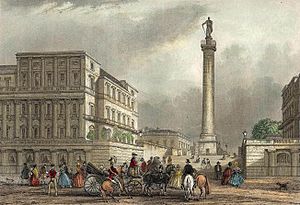Duke of York Column facts for kids

The Duke of York Column seen from The Mall.
|
|
| Coordinates | 51°30′22.8″N 0°7′54.5″W / 51.506333°N 0.131806°W |
|---|---|
| Location | London, England |
| Designer | Benjamin Dean Wyatt |
| Type | Monument |
| Height | 137 ft 9 in |
| Opening date | 10 April 1834 |
| Dedicated to | Prince Frederick, Duke of York |
The Duke of York Column is a tall monument in London, England. It was built to honor Prince Frederick, Duke of York and Albany. He was the second son of King George III. The column was designed by Benjamin Dean Wyatt. You can find it where Regent Street meets The Mall. This wide area is called Waterloo Place and Gardens. The monument was finished in 1832. The statue of the Duke was placed on top in 1834.
A Look Back
Prince Frederick, Duke of York and Albany was an important leader. He was the commander-in-chief of the British Army. He helped make the army stronger and more modern. This was during the French Revolutionary Wars. Many people remember him from the children's nursery rhyme, "The Grand Old Duke of York".
When he passed away in 1827, the entire British Army wanted to build a monument for him. They all agreed to give up one day's pay. This money helped pay for the column.
Once enough money was collected, architects were asked for ideas. In 1830, they chose a design by Benjamin Dean Wyatt. A builder named Nowell was hired to construct the column. Work on the foundations started in April 1831. The ground was dug deep, about 22 feet (6.7 meters) down. Strong stone slabs were used to make the base solid. The foundations were ready by June 1831. Building the stone column began soon after.
What It Looks Like
The column is built in a style called the Tuscan order. It is made from granite stone from Aberdeenshire in Scotland. Different shades of grey and a warm beige granite were used. There is a metal railing at the top of the column.
On top of the column is a bronze statue of the Duke. He is wearing the special robes of the Knights of the Garter. This statue was made by Sir Richard Westmacott. It is 13 feet 6 inches (4.1 meters) tall. It weighs about 16,840 pounds (7,638 kilograms). The statue was lifted into place on April 8, 1834.
The monument, from its base to the top of the statue, is 137 feet 9 inches (42 meters) tall. The Duke's statue faces towards the south. From its base, you can see great views of The Mall and St. James's Park.
Inside the column, there is a spiral staircase with 168 steps. Small openings let light into the staircase. This staircase leads to a platform around the statue's base. However, this staircase has been closed to the public for many years. This is because the platform is small and many people wanted to climb it.
The Duke had a lot of debt when he died. Because the column was so tall, some people joked that he was trying to get away from his money problems!
The wide road where the column stands was designed by architect John Nash. He planned it as a grand entrance to London. Wealthy families and important politicians lived in the beautiful buildings nearby.
See also
 In Spanish: Columna del Duque de York para niños
In Spanish: Columna del Duque de York para niños


